Paddleboarders are not invulnerable or invincible. They are humans, so whenever water and weather conditions are unsafe, they refrain from paddle boarding. That being said, what conditions are ideal/safe for paddle boarding?
What are the best conditions for paddleboarding?
One of the best conditions for paddleboarding is mild wind. Light wind blowing away from the land makes the surface of the water calm. Of course, with calm waters comes a lower risk of injuries while paddleboarding. Calm offshore winds will also help create beautiful glassy conditions on the water.
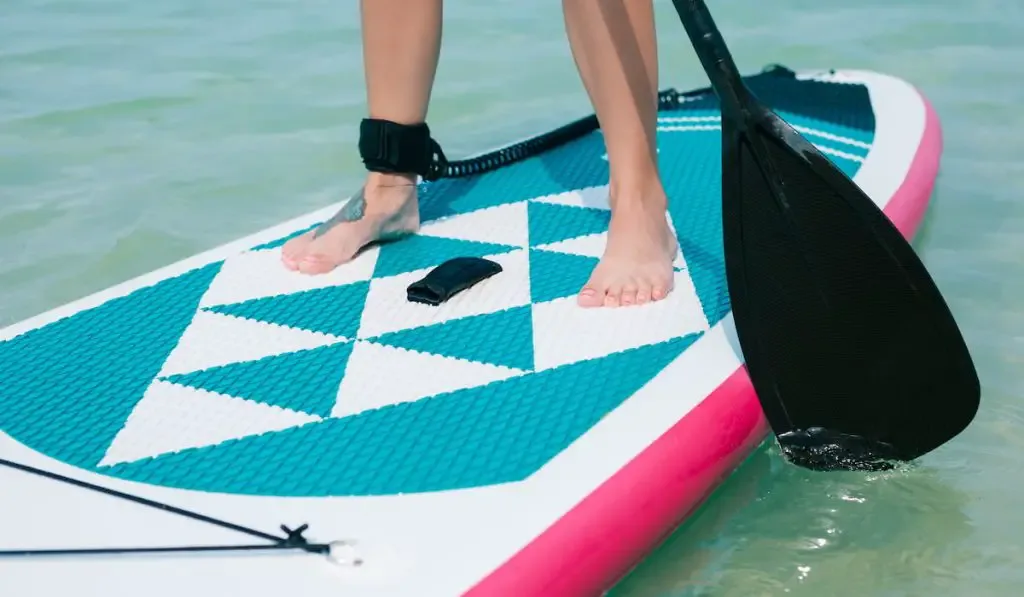
Besides the wind, some other conditions can determine when paddle boarding is ideal or not ideal. In this article, we discuss these conditions. We also talk about paddleboarding in winter and on choppy waters.
What Are the Ideal Conditions for Paddleboarding?
At What Speed Is Wind Good for Paddleboarding?
The wind is one of the primary factors that affect the performance of a paddleboard. This is why checking the wind forecast before you go paddling is essential.
Generally, if the wind speed is below 10 knots, it is safe to go paddleboarding regardless of your skill level. Wind speeds over 10 knots can be challenging for those not confident in their stamina or technique.
When Is It Too Windy for Paddleboarding?
If you are new to paddleboarding, you should know your limits. Going paddleboarding on a windy day can put you in danger. Wind speeds above 10 knots can create choppier waters which are unsafe for inexperienced paddlers.
Beginners should only go paddleboarding on days with minimal wind. Although more experienced paddlers may favor windier conditions. It is pretty commonplace for skilled paddlers looking to race to paddle in windy weather. But they still need to be cautious of strong winds.
If you go paddleboarding on days with high wind speeds, you may find it difficult to remain balanced and afloat.
What Temperature Is Good for Paddleboarding?
In general, the best temperature range for paddleboarding is between 70 and 85°F. However, you may find that the preferred temperature varies from one person to another. So, in the end, the best temperature for paddleboarding often depends on individual preference.
When Is It Too Cold for Paddleboarding?
Water temperatures around 50 to 60°F can be dangerous for paddleboarders.
Within this temperature range, cold water immersion poses significant risks. So, if you intend to go paddleboarding in those temperatures, do not go without a plan. Also, acquaint yourself with the risks involved and have lots of experience.
At temperatures below 40° F, you would not like the pain that comes with water touching your skin.
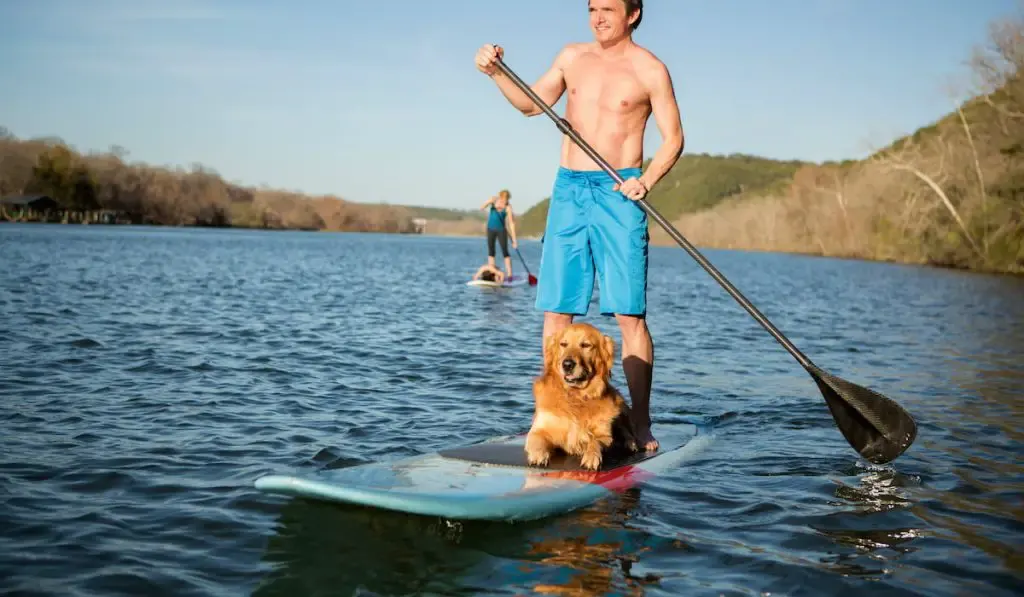
Is It Safe to Paddleboard in the Ocean?
Paddleboarding in the ocean can be risky if you choose to ignore the dangers. For instance, if you decide not to wear your leash and inevitably fall off your board, the board will either be pulled by the current, kicked away as you fall, or blown by the wind.
When you go paddleboarding in the ocean, you will be subject to whatever it throws at you. One minute you are on your board, and the next, you are trying to keep your head above the water while your board floats away.
How Do You Stay Warm When Paddleboarding?
When you go paddleboarding in the summer, you only need swimwear. But in winter, you need clothes that will keep you warm.
In winter, the water is cold, and if you fall in, you can become hypothermic. So, when you go paddleboarding in such conditions, ensure you put on enough layers of clothing to keep you warm. You can try fleece clothing since it can help you maintain your body heat.
Besides your torso, you must protect other parts of your body like your ears, face, and hands. To keep your feet warm, you will need thermal socks. For your hands, thick gloves will do, and you can wear a hat to protect your head and ears.
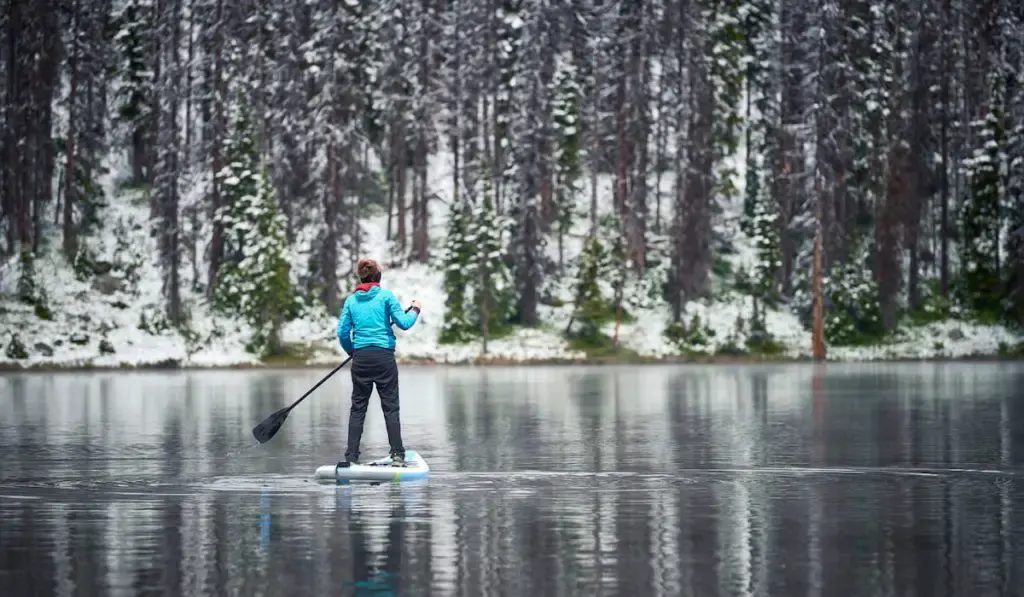
Is It Safe to Paddleboard in Winter?
It is dangerous to go paddleboarding in cold temperatures unprepared.
Before you go paddleboarding in winter, do some research on the area you plan to paddle.
Always remember to check the weather forecast for that day. If there will be high winds or below-freezing temperatures, do not go.
Never paddleboard alone in extreme weather conditions. To be safe, always go with some friends.
11 Tips for Paddleboarding in Winter
Here are 11 helpful tips for paddleboarding in winter:
Ensure Your Gear Is in Good Working Condition
Before you go paddleboarding in winter, ensure your gear is in good working condition. Falling in cold water without the proper equipment can be a horrible experience.
Not all paddleboards are suitable for winter use. Ensure your paddleboard is sturdy enough to handle cold weather. And if you have not used your board for a while, check the pressure.
If you want the board to remain high on the water and sturdy go for 20 PSI.
Use a Paddleboard Leash
Most people believe they do not need a leash in flat water. However, this is not true. Even experienced paddleboarders need a leash when they are on their board. In winter, you must always wear a paddleboard leash.
A paddleboard is a large floatation device, and a leash will ensure you remain attached to it just in case you find yourself in any trouble.
Be Prepared for Accidents
Even when you have a leash attached, it is almost impossible to avoid accidents. However, if an accident occurs, ensure you are prepared to avoid freezing to death or drowning.
You must have a floating device that will help you stay afloat when you fall in the water. A life vest, for instance, will lift you above the water, allowing you to conserve the energy needed to get to shore.
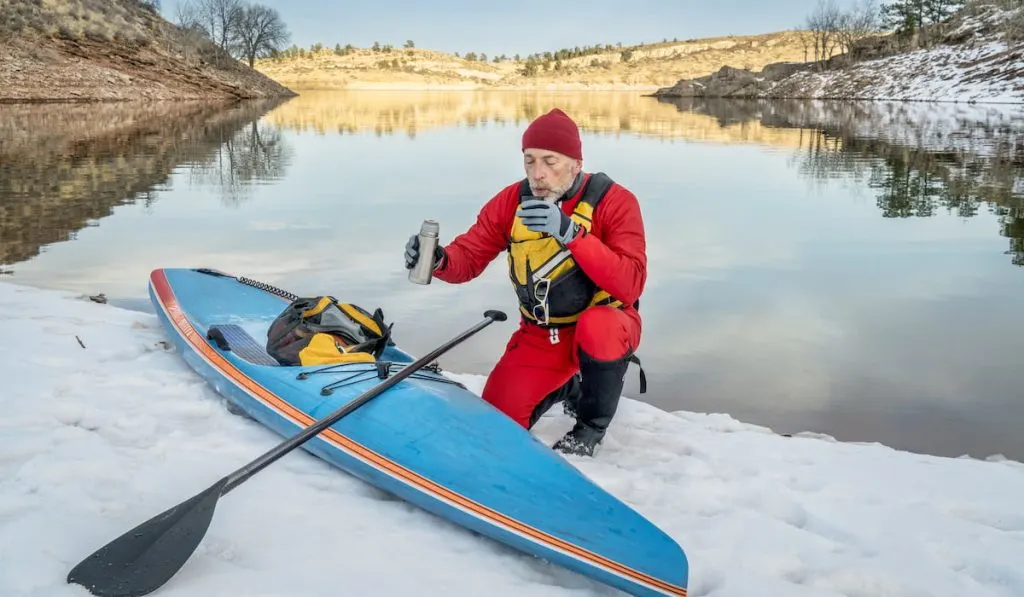
Wear the Proper Winter Clothing
When you go paddleboarding in winter, you will need the proper winter gear. Put on layers of clothing, starting with a moisture-wicking material at the base. Then add other layers for wind protection and warmth.
You can put on running tights for your legs and cover your feet with water boots or shoes. For your hands, a pair of gloves with enough grip will be fine.
In cold weather, a lot of heat is lost through the head. So, cover yours up with a lightweight hat.
Avoid wearing clothing or materials made from cotton. Cotton gets soaked in the water readily, and this can result in hypothermia.
Pack an Extra Set of Clothes
When you go paddleboarding in winter, try to pack an extra set of clothes that you can change into once you finish your session.
You can pack a jacket, sweater, pants, and towel in your car. This way, you will have something to help you stay dry and warm once you finish in the water.
You can also pack something warm to drink or eat in a thermos.
Wetsuit or Drysuit?
If you are a white water rider or surf paddler, you will need some form of protection, especially when the weather is cold.
A wetsuit remains heated while keeping water trapped between your body and the suit. A drysuit, on the other hand, is totally waterproof and provides more protection.
If you paddleboard in the cold and spend time in and out of the water, go for a wetsuit. If you are paddleboarding in calm or flat waters, you will mostly stay dry, and you may not need a wet suit.
Check the Weather Forecast
Precipitation-free skies and light winds offer the best conditions for paddleboarding. So, look out for them in the forecast.
In winter and fall, the weather changes quickly. So, trying to beat the storm may not work in your favor. Snow or rain can hamper your vision when you are on the water. Obviously, once it becomes difficult to see what is ahead of you, you may start to drift off course.
All in all, if you are unsure about the weather, it’s best not to go out, especially in winter.
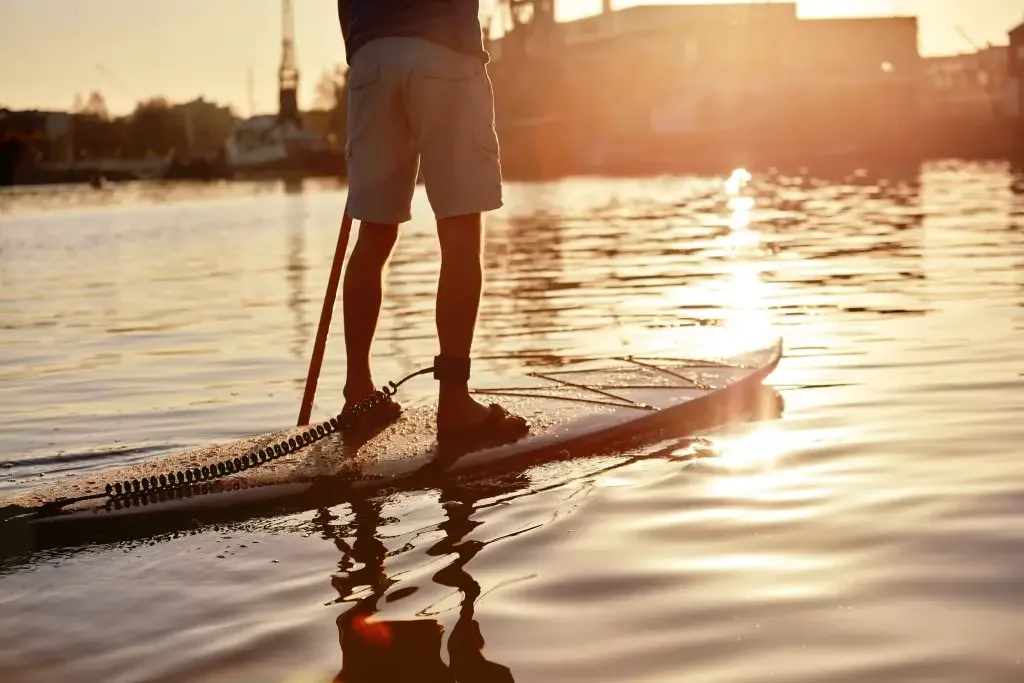
Paddle Only In Water
When you go paddleboarding in winter, avoid ice. Ice is unpredictable, heavy, sharp, and will not do you or your paddleboard any favors.
If you are going to paddle in winter, ensure you steer clear of any frozen areas. Avoid using ice as a bridge to get to the water, and if there are large chunks of ice floating around, do not stand up on your paddleboard.
Do Not Stay Out Too Late
Remember, in winter, the sun sets pretty early. Temperatures tend to drop rapidly even before the sun goes down. When you venture out, ensure you are out of the water before the sun sets.
Check your local weather forecast to find out when the sun will set. This will allow you to keep to time. Plan to get out of the water 30 minutes before sunset.
Always Stay Close to Shore
Ensure you always remain close to shore.
Never venture too far from shore because you can only swim for a short period in cold water. The distance a person will cover in cold water depends on how much cold they can endure. If you are going paddleboarding in winter, avoid your usual paddling routes and remain close to shore.
Do Not Paddle Alone
This tip applies to both winter and summer. When you go paddleboarding in winter, it is essential to have a paddleboard partner.
If you insist on paddling alone, ensure you tell someone where you will be boarding and when you will return. Remember to call once you get back so that your friends know you are safe.
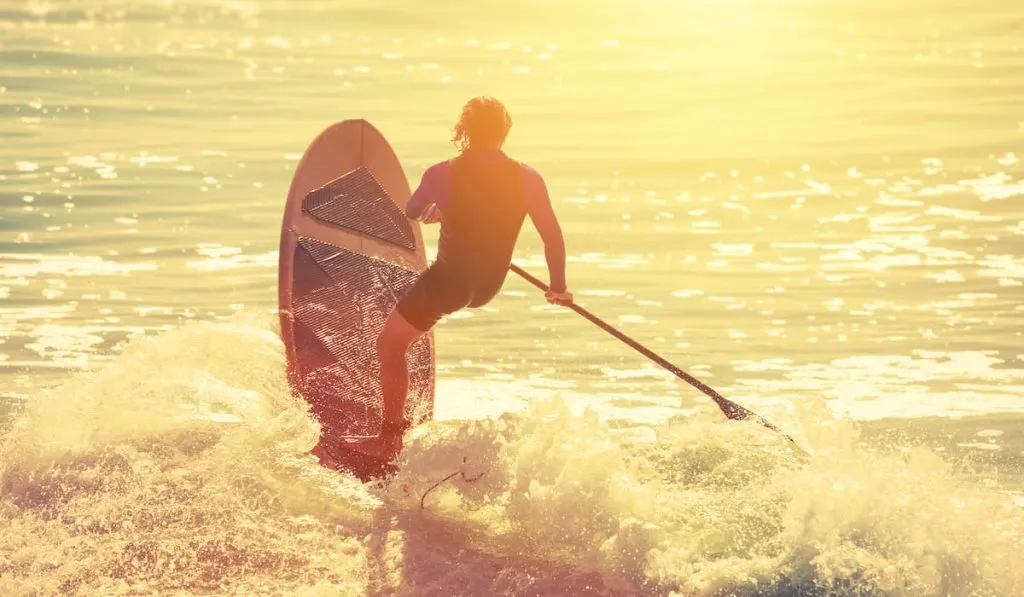
How Do You Paddleboard in Choppy Water?
When the water is choppy, its direction becomes non-uniform. As a result, you will be unevenly rocked while paddling.
To paddleboard in choppy water, you need to have a broad and steady stance.
- You can place your feet apart slightly further than your shoulder width. Doing this ensures your weight remains at the center of your body.
- If your board gets rocked, you can transfer your weight to the relevant leg to retain your balance.
- Bend your knees slightly. Bending your knees a tad makes it easier to make micro-adjustments on your board. It also ensures you are balanced and stable, and it keeps your legs engaged.
- Do not lock your legs, or you risk losing your balance.
Final Thoughts
When you go paddleboarding, ensure the wind is light – the weather forecast should help with this. Strong winds stir the surface of the water and make it less stable. Consequently, the chances of paddleboarding injuries increase.
Paddleboarding in winter can be very enjoyable, but it can also be dangerous if you are unprepared. So, you have 2 options: stay indoors or go well-prepared.
Resources:
- https://www.cruisersup.com/blogs/sup/winter-sup-tips
- https://suptilsunset.com/paddle-board-in-choppy-water/
- https://standupsurfshop.com.au/blog/when-to-go-stand-up-paddling-get-perfect-conditions/
- https://fitfunsup.com/how-to-stand-up-paddle-board-in-the-ocean-5-main-keys/
- https://supready.com/best-conditions-for-paddle-boarding/
- https://passion4paddleboards.co.uk/articles/paddleboarding-when-its-windy/
- https://www.islesurfandsup.com/blog/cold-weather-paddle-boarding/
- https://www.earthriversup.com/info/sup-news-and-articles/cold-water-paddle-boarding-the-critical-guide/
- https://www.twobarefeet.co.uk/blog/safe-wind-speed-for-paddle-boarding.html
- https://standuppaddleboardworld.com/paddle-boarding-in-cold-temperatures/
